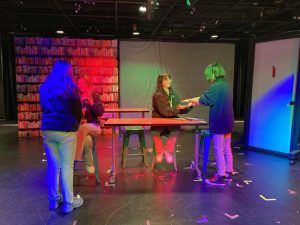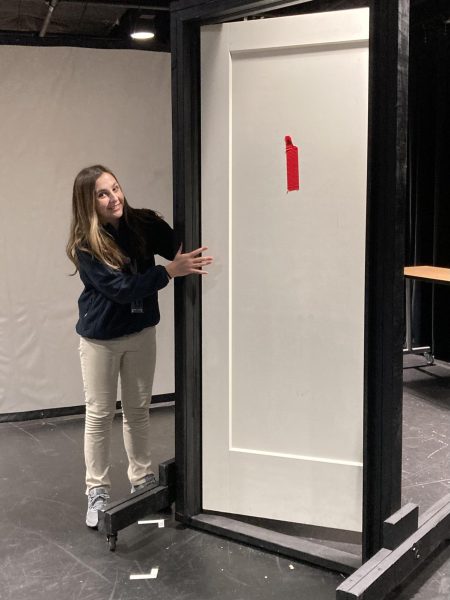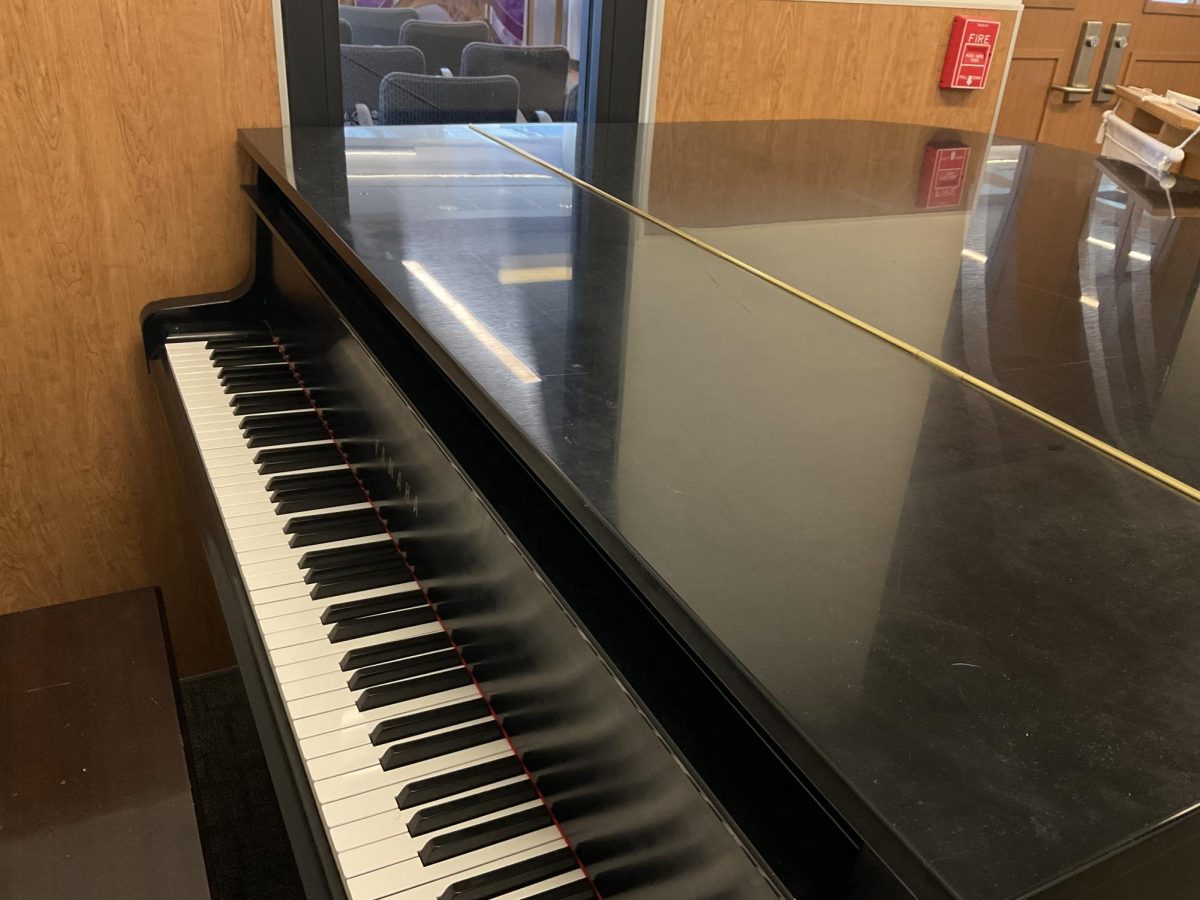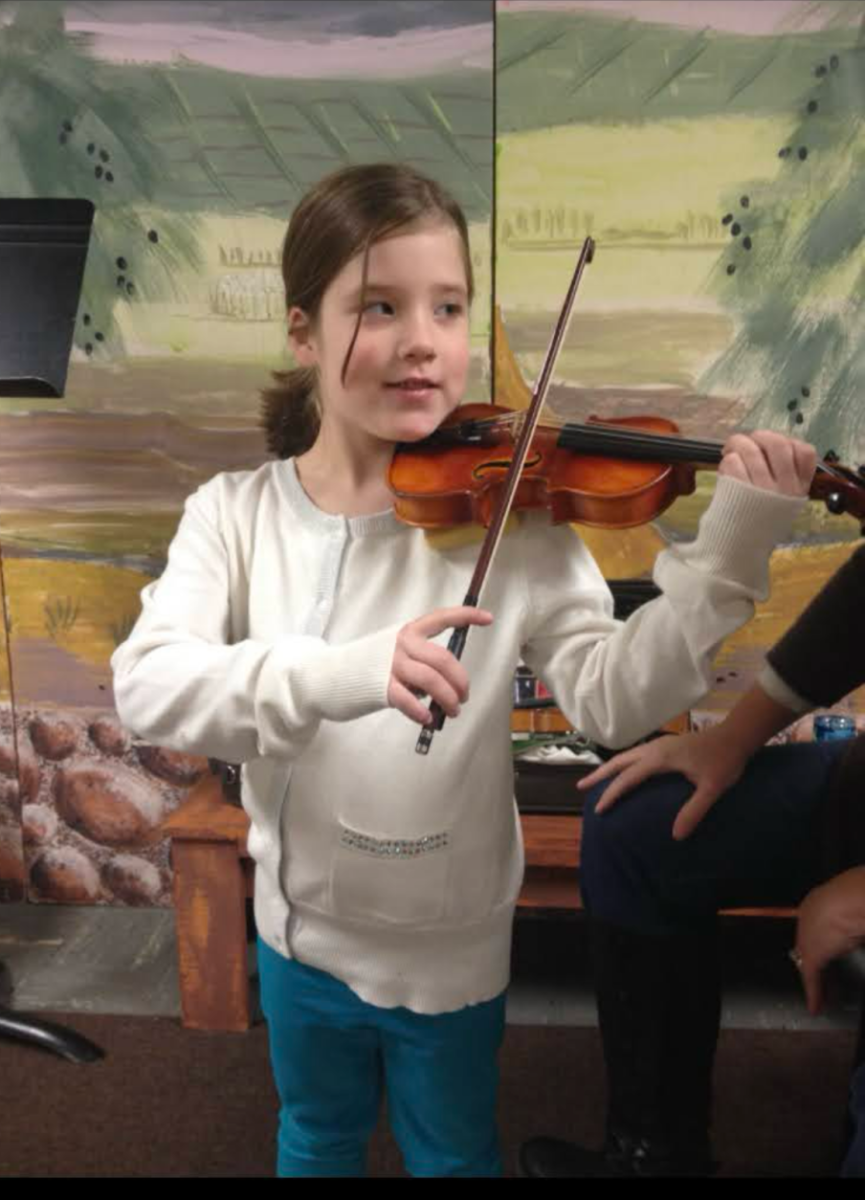Theater students at DePaul College Prep hope to do something different this year. While most high schools are preparing traditional classics for their approaching fall productions, whether that be Shakespeare’s “Romeo and Juliet” or “A Midsummer Night’s Dream,” the DePaul Prep theater program is aiming to put on a relevant production that forces audience members to think critically about a tragic topic and its connection to the way individuals ingest information.
The school production will be performed by a total of 17 students, which includes 12 actors and five crew members. Leading this group will be Craig Bryant, an English and Theatre teacher who’s been teaching at DePaul Prep for 13 years. He’s directed several high school plays in the past, but none he considers “this sensitive or this relevant.”
Students are preparing a play about a school shooting.
“The Library” is a collaboration between director Steven Soderbergh and writer Scott Z. Burns, inspired by the late Columbine High School Massacre of 1999. It focuses on the effects of a school shooting as a small community comes to terms with its losses. Amid the grief, confusion, and a deceased school shooter, community members seek to put the blame on someone. They consequently turn to the main character, Caitlin Gabriel, a student and shooting survivor herself. Throughout the story, Gabriel must face the accusations of her community and brutality of the media, leaving the audience questioning whether she was truly responsible for the death of her peers.
As audience members witness the plot unfold, they must confront heavy themes that deal with the ideas of truth and perception while they examine statements from the media and Gabriel in order to determine what really happened that day.
“We live in a time where it’s real easy to believe certain stories,” Bryant said. “We don’t always do our own investigation, or we don’t do enough of our own seeking in terms of finding what may really be there.”
Since auditions were conducted from September 5th-7th, both the cast and crew have participated in weekly rehearsals to bring the plot to life. Each student’s role determines their schedule.
According to junior Angelina Girardin, who plays the lead of Gabriel, she and other actors have practices six days a week for multiple hours at a time.
“On Mondays and Fridays, it’s three thirty to five. On Tuesday, Wednesday, Thursday, it’s three thirty to six. Saturday could be eleven to three,” said Girardin.
Though no matter if a student is part of the cast or crew, expectations for commitment remain high.
“Mr. B says it’s more intense than a varsity sport,” sophomore Maria Dahaner said. “Going into it, that’s what you need to know.”
Dahaner had never participated in a DePaul Prep production until she decided to join the backstage crew this school year. After accidentally attending a cast meeting and forming a connection with the acting community, she became regularly involved in their rehearsals. Now she works with both cast and crew, mainly managing scene transitions and assisting actors with memorization and cues.
“Some of the actors say she knows their lines better than they do,” remarked Simon Periolat.
Even though junior Periolat serves as the student director for backstage crew, they “mostly focus on lighting.” A large emphasis will be placed on lights during the performance in order to immerse the audience in the story and communicate the core messages.

“In terms of light, we’re just trying to be as creative as we can,” they explained. “Like, you know, make a situation where she’s in the hospital and she’s dying seem over dramatic and overly urgent because that’s how we want the audience to feel.”
While lighting influences the mood, sound will be used to indicate the time frame of each scene.
“Our sound [team] is talking about using ambience, which is a way of specific sounds playing,” said Periolat. “So you know what scene you’re in and where you’re at.”
Scenes will be made as realistic as possible through the use of various techniques in order to depict true trauma. Fake blood, for example, will be one tool used by actors.
“There’s a couple of scenes where she’s in a hospital,” said Dahaner. “There’s a scene where she has to open her shirt and there’s blood. We need to tell the audience she’s ruptured something, so there needs to be blood on her shirt.”
The combination of all backstage and onstage elements performed by both the cast and crew will be used to illustrate the play’s main message about truth, prompting audience members to grapple with how they form their own opinions and where the information they consume comes from.
“Truth is fickle and intangible…This is like what they drive home in the last scene of the play,” said Dahaner. “Britannica—that’s a trusted source. But who decided Britannica was a trusted source? Like, how do you know the truth? You don’t.”
The production expresses that experience, opinion, and truth clash to write a story consumed by others, who then use it to form their own. Consequently, different accounts of the same event can be produced with potentially no retelling fully encompassing what happened.
As Dahaner stated, “There is no one truth.”
During the performance, this concept will be depicted through the use of books due to the similarities they share with stories.
“Because [the play] takes place in a library, books serve as a symbol for stories themselves. And I think because this play is about stories and narratives and how they get told and who gets to control them, books are important,” said Bryant.

An additional major prop is a door, which acknowledges Gabriel’s alleged betrayal.
“One of the major elements of what happens in the story, of what goes on, is a number of the victims were hiding in an audio-visual closet, and there’s a lot of speculation about who tipped off the shooter to the fact that they were in there. So the door becomes a running theme—a running motif,” explained Bryant.
“The Library” first came up last school year when students were brainstorming ideas for future plays. Bryant had been contemplating the production for a long time, which ultimately led to its introduction.
“I read a lot of plays, and this is one that’s been sitting on my shelf for awhile,” said Bryant. “It caught my eye because the writer is a screenplay writer.”
Screenplays have shorter scenes compared to traditional theater entertainment. Bryant defines them as pieces containing a lot of “episotic, kind of short-scene work.”
When he presented the concept, the majority of students produced a positive response. Most were highly engaged by the storyline, and some students even listed the production as their top choice for future performances.
“This is one that got a lot of traction,” Bryant said. “There were a lot of people interested in this topic because it’s something they felt they knew. Something they felt was part of their experience.”
Despite students’ excitement, Bryant doubted the production would be passed by school administration due to its negative connection with schools.
When DePaul Prep’s principal Dr. Stanton-Anderson and President Dempsey both approved the production, Bryant and students were completely shocked but thankful for the unique opportunity.
“I was surprised. I was surprised because we are in high school. This is a play about a high school shooting. It’s a sensitive topic, for sure, and I’m glad that this administration has let us do this,” Dahaner said.
Ferill Kelley, a junior who acts as Gabriel’s mother, agreed.
“We got a synopsis, back in probably like June, about what this play was,” she said. “This was the play I wanted to do, but I didn’t think I would be able to do it.”
Through “The Library,” students, faculty, and staff are able to confront a tragic event. The creation of this safe space was the main reason behind the production’s approval.
“Through the art of theater, I believe the ‘The Library’ provides an outlet for us as a community to talk about something that is very difficult to discuss,” said Dr. Stanton-Anderson.
“I hope and pray everyday that our community never has to face such a scenario on any level, but I also acknowledge that this is now a modern day fear that our students, faculty and parents must carry daily.”
Recognizing and acknowledging these fears allows for individual growth that benefits the community as a whole.
“Facing those fears through conversation may be able to help us process and possibly prevent such a situation from happening here at DePaul Prep,” Dr. Stanton-Anderson said.
Overall, Bryant aims for the audience to resonate with the play. He hopes they recognize how destructive the effects of a major event can be on a community, and how one event can evolve into multiple stories based on its initial source.
As Bryant stated, “I think there’s a lot more things to this than the day the event happens. I think what the play is trying to talk about is: after all the smoke clears, after everything is kind of put away, there are so many unresolved issues…It continues to hurt people after the last shot is fired.”







